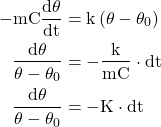Statement
Newton’s law of cooling states that the rate of cooling of a body is directly proportional to the temperature difference between the body and the surroundings.
The law holds good only for a small difference of temperature. Loss of heat by radiation depends on the nature of the surface and the area of the exposed surface.
If θ be the temperature at the instant of the cooling body and θ0 be the temperature of surroundings, the rate of loss of heat of the body
 eqn (1)
eqn (1)
Negative sign indicates that the heat is lost. The proportionality constant depends upon the shape, area and nature of the exposed surface.
Derivation
Consider a body of mass m, specific heat C and at temperature θ. Let θ0 be the temperature of the surroundings. Suppose, that temperature falls by a small amount dθ in time dt. Then the amount of heat lost.
dH = mCdθ
∴ Rate of loss of heat
eqn (2)
![]()
From Newton’s law of cooling, the rate of heat is proportional to the difference of temperature (θ-θ0)
eqn (3)
![]()
Where K is a constant depending upon the area and the nature of the surface of the body.
From eqn. (2) and (3)
 eqn (4)
eqn (4)
K=(k/mC) being another constant and is independent of t. Integrating both sides of eqn.(4)

Here, C is integration constant. A graph between loge (θ−θ0)and t must be a straight line.
| Read More Topics |
| Expression for bending moment of a beam |
| Crystal physics – solved problems |
| Poisson’s Ratio(σ) |





